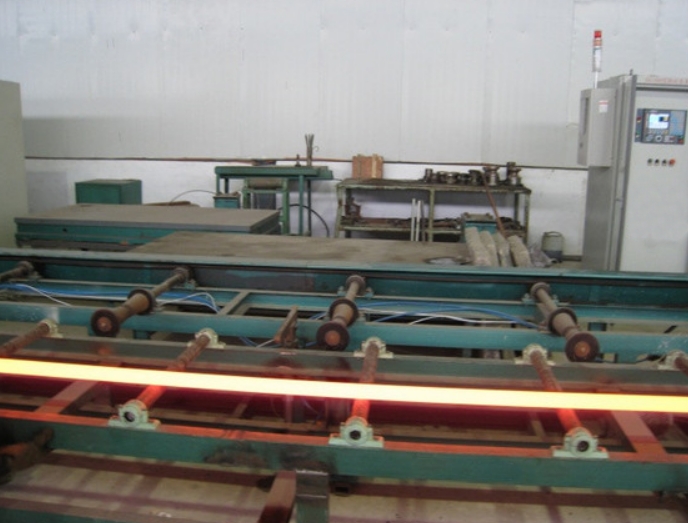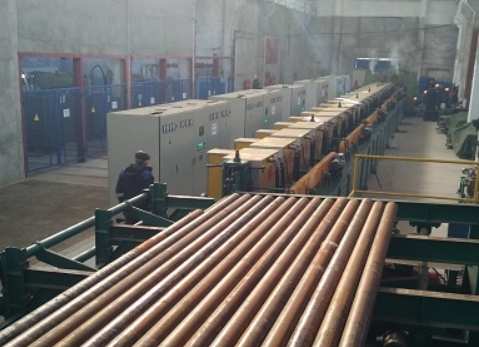- 14
- Sep
Ọkụ nchara gbara gburugburu na ọkụ ọkụ
Ọkụ nchara gbara gburugburu na ọkụ ọkụ
The round steel quenching and tempering furnace mainly uses induction heating modulated by round steel, bar stock, wire, and steel rod to realize the quenching and tempering function.

1. Main technical indicators of round steel quenching and tempering furnace production line
1. Quenched and tempered material: 30MnSi
2. Nkọwa nchara na waya: Φ7.1-Φ12.6mm
3. Imebi okpomọkụ: 930-960 ℃ Okpomoku dị ọkụ: 400-460 ℃
4. Ịkụ ọkụ n’ike ọkụ nke igwe anaghị agba nchara na nnukwu ọkụ: ihe dịka 370 degrees/ton
5. Ọnọdụ na -arụ ọrụ nke ọkụ ọkụ na -enwu enwu na ọkụ ọkụ: sistemụ na -arụ ọrụ na -aga n’ihu
6. Center elu nke gburugburu ígwè na -emenyụ na tempering ọkụ mmepụta akara: 1000mm
7. Feeding direction of round steel quenching and tempering furnace production line: left (right) feed
8. Ihe nkesa ike chọrọ maka imenyụ nchara nchara na ikpo ọkụ: ngụkọta arụnyere nke ahịrị ọ bụla: afọ 1250KVA.
9. Round steel quenching and tempering furnace output: 60,000 tons/year, consisting of 4 lines.
10. Ọsọ kacha arụ ọrụ nke agba nchara gbara gburugburu na imepụta ọkụ na -ewepụta ọkụ:
7.1mm ———— 100m/min
9.0mm ———— 90m/min
Φ10.7mm ———– 60m/min
Φ12.6mm ———– 40m/min
12. Cooling water requirements for round steel quenching and tempering furnace production line (single line):
a. Mmiri na -ekesa mmiri jụrụ oyi
Na -asọ: 100m3/h Nrụgide: 0.4MPa
Water temperature: not higher than 33℃
Water quality: Urban water supply water quality standard CJ/T206-2005 (Ministry of Construction)
b. Mmiri jụrụ oyi maka itinye ọkụ ọkụ ọkụ:
Na -asọ: 100m3/h Nrụgide: 0.4MPa
Water temperature: not higher than 33℃
Water quality: Urban water supply water quality standard CJ/T206-2005 (Ministry of Construction)
c. Compressed air requirements (single line):
Ọgwụ: 3m3/min Nrụgide: 0.6MPa Ọnọdụ mmiri: adịghị elu karịa 33 ℃
Compressed air quality: GB/T13277-91 “Compressed air quality grade for general use”
2. Nhazi akụrụngwa na nkọwa nke nchara nchara gbara gburugburu na ahịrị mmepụta ọkụ:
A na-emepụta ihe nchara okirikiri ọ bụla na ọkụ na-enwu ọkụ PC nchara ígwè site na ịbịpụta akụrụngwa, akụrụngwa nnyefe traction, ike mgbanwe static ugboro ugboro na-enye ọkụ ọkụ ọkụ, itinye ọkụ na-ebunye ọkụ, ịgba mmiri jụrụ oyi, ịkwọ ụgbọ mmiri hydraulic na ịtụgharị akụrụngwa, were waya. akụrụngwa, yana moto AC Ọ nwere sistemụ nchịkwa ugboro ugboro na -agbanwe agbanwe, sistemụ njikwa PLC, sistemụ nha okpomọkụ na ngalaba njikwa etiti.
Ngwa akụrụngwa ọ bụla nke mmepụta gụnyere:
1. Akụkụ usoro:
Nkwụ ụgwọ ịkwụ ụgwọ
Ogwe njikwa eriri 1
Mechanical derusting machine 1
Drawing forming machine 1
Igwe ịgbazi 1 setịpụrụ
Igwe nhicha 1
1#Towing machine 1 set
Quenching water tank 1
Ihe mkpuchi mmiri 1
2#igwe traction 1 setịpụrụ
Igwe ntụgharị ihu igwe hydraulic 1 set
Take-up machine 2
2. Nhazi nke ọkụ nchara na -enwu enwu:
KGPS-500KW/6KHZ medium frequency induction heating power supply 1 set
CYP-200KW/40KHZ IGBT super audio frequency induction power supply 1 set
CYP-200KW/50HZ IGBT super audio frequency induction power supply 1 set
KGPS-250KW/8KHZ KGPS ugboro ugboro itinye ọkụ ọkụ ọkụ 1 setịpụrụ
Otu setịpụ kabinet ntughari ugboro
90KW (draịva igwe na -ese ihe) 1 setịpụrụ
5.5KW (mbanye nke igwe akara) 1 setịpụrụ
11KW (nke traktọ na -akwagharị) 2 setịpụrụ
4KW (draịva nke igwe na-eburu) 2 set
Operation console and operation box 6 sets
Isi njikwa 1
Igbe eji arụ ọrụ 2 set
Igbe ọrụ na -agba ọsọ (mgbada n’igwe, traktọ, igwe ịse ihe ọ bụla) 3
Thermometer (nha nha nha 300-1000 ℃) abụọ
3. Ngwakọta ihe eji arụ ọrụ na arụmọrụ teknụzụ nke imenyụ nchara nchara na ọkụ ọkụ
(1) Ọdịdị na-atụgharị ogwe aka okpukpu abụọ nke etiti akwụ ụgwọ, a na-ejikọ ogwe aka etiti na kọlụm edoziri site na iburu ya, aka uwe nwere ike tụgharịa ma tinye ya nke ọma, a na-ejikọkwa ogwe mkpanaka mkpanaka waya na etiti. aka site na mkpọchi, nke nwere ike ịtụgharị nwayọ mgbe ị na -agbanwe ụda, ma debe ya mgbe ị na -akwụ ụgwọ, ọ dị mma ijikọ isi mkpanaka waya na ọdụ.
(2) Ogwe njikwa waya Ogwe njikwa waya bụ ihe teepu, na ebumnuche ya bụ ịgbanwe ụdị mgbanaka mkpanaka waya ka ọ bụrụ ahịrị kwụ n’ahịrị iji gbochie wiwi ndị na -akpaghasị.
(3) Mechanical rust remover Onye na-ewepu nchara nchara mebere rollers na-ehulata ugboro abụọ 2. N’ịbụ nke onye na-ebuli moto-lifter-lead screw (ma ọ bụ pneumatic) na-akwagharị, a na-akwagharị ihe mgbagharị na-ebugharị ebugharị ka ịgbatị ma ọ bụ weghachite. Gbaa mbọ hụ na akụkụ ekwe ekwe zuru oke n’etiti ogwe nchara na rola rolle na -ehichapụ ihe oxide ka ọ kacha. Mgbe akpachapụrụ akpụkpọ oxide ahụ, ọ na -adaba na tankị dị n’okpuru maka nhicha dị mfe. A na -anabata usoro nke emechiri emechi ka ọ ghara ikpo uzuzu n’ime ogbako ahụ.
(4) The PC steel rod concave thread forming of the drawing machine adopts the method of matching the drawing speed and the rotation speed of the mold. The mold is well stressed, the mold life is long, and the lead of the steel rod is artificially controlled to ensure the appearance quality of the product. The reducer of the wire drawing machine adopts a medium-hard tooth surface reducer, and there are protective devices at the tank body and the belt. The wire drawing tank is equipped with a shut-down pneumatic pinch roller to prevent the machine from shutting down and disordering the line. The diameter of the reel is 900mm, the maximum drawing speed is 100m/min, the wire drawing machine motor is 90KW, and the rotary die motor is 5.5KW.
(5) igwe kwụ ọtọ Igwe na -agbatị agbachi agbachi ma nwee nchịkọta mpịakọta abụọ na -akpụ ogo 90 n’otu n’otu. N’okpuru ike nke traktọ, ọ na -etolite esemokwu na -agbatị ma na -agbatị ogwe nchara.
(6) igwe ịsa ahụ Igwe eji asacha ihe nwere eriri abụọ nke wiil waya nchara, nke moto na -akwagharị, iji wepu irighiri n’elu mkpanaka igwe. Mkpụrụ moto ahụ bụ 2KW, onye na -ebelata ya bụ onye na -ebelata nnyefe na -agbanwe agbanwe.
(7) There are two tractors. They are respectively placed in front of the quenching heating furnace, and after the tempering and cooling device, they play the role of full-line dragging. The traction machine is composed of three pairs of traction rollers, the lower roller is active and the upper roller is passive. The lower roller device is on the output of a non-standard transmission box with a single shaft input and three output shafts. The upper roller device is in the chute of the upper sliding frame. Keep to ensure the clamping force of the steel bar and ensure the smooth operation of the steel bar. The two tractors adopt micro-tension control technology, which can adjust the tension at any time according to the process needs and keep it between the two tractors. The micro-tension control technology can be used to adjust the tension and maintain at any time according to the process needs, which is automatic control between the two tractors. Under the formation of constant tension to provide guarantee to meet the needs of product quality. The traction roller is composed of two grooves, and the traction roller is arranged on the optical axis through an expansion sleeve to facilitate the replacement of the traction roller. The motor is 11KW, and the reducer is a planetary cycloid reducer.
(8) Ịmecha na ime ka ngwaọrụ jụrụ oyi Ngwa igwe jụrụ oyi na ịcha ọkụ bụ nke igwe anaghị agba nchara, ụzọ jụrụ oyi bụ mmiri jụrụ oyi, a na -ejikwa ngwaọrụ ikuku ikuku na -ejedebe. Tankị ọkụ a na -agbanyụ ọkụ bụ mita isii n’ogologo, na tempering tank dị mita 6 n’ogologo
(9) Hydraulic na -atụgharị igwe na -akpacha ajị na -ekwe nkwa ịbelata na ịtụgharị dị ka ihe chọrọ nke mbepụ ngwa ngwa nke ahịrị mmepụta, na -ahụ na ntụgharị 100% ịkpụgharị ajị agba, yana hụ na arụ ọrụ na -aga n’ihu nke ahịrị mmepụta. Moto ụgbọ ala hydraulic bụ 2.2KW.
(10) Emebere igwe eji eburu ihe dị ka ihe a chọrọ si kwuo nkwụnye ụgwọ nchara, yana ọsọ ntụgharị nke ihe na-ebuli elu na-agbanwe mgbe niile na ọsọ ọsọ nke ogwe nchara, na-amata eriri oge niile. Moto ahụ dị 4kw, onye na -ebelata ya bụ ihe na -ebelata ihe ikpuru. 
